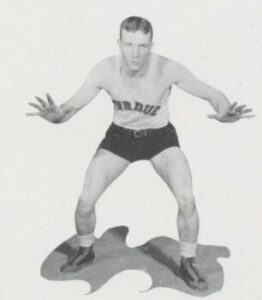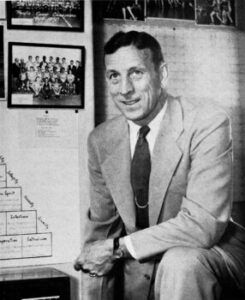This is a story about excellence. There are some people out there who are just really good at almost everything they try. Some of that might come from a natural talent or disposition. Some of it might come from hard work. But more often than not, it comes from a combination of both. But how does someone reach a world-class level of excellence in two related, but still unique disciplines? What drives someone to be the absolute best at something? Hopefully, we can answer that today.
The subject of today’s post is the first person to be inducted into the Hall of Fame twice. His name is John Wooden, which should be obvious since his name is in the title above.
Before Wooden ever won his first championship as the coach of the UCLA Bruins, he had already been inducted into the Hall of Fame as a player. But we do not often hear about his playing days. We only hear about his coaching days.
Wooden's Upbringing
John Wooden was born on October 14, 1910, in Hall, Indiana to Joshua and Roxie Wooden. His parents were farmers and they lived in a house with no electricity or indoor plumbing. Coach Wooden was raised along with his 3 brothers as farm kids. He did have two sisters, but each died before their 2nd birthday. His home was filled with love and discipline. It is hard to grow up on a farm and not have a sense of discipline.
Farm life is hard.
There is no such thing as sleeping in. Chickens need to be fed. Cows need to be milked. Chores need to be completed. The farm does not take a day off. It was this discipline and approach that he brought to his development as a basketball player.
During high school, his family moved to the town of Martinsville where he played on the school’s basketball team. He was a three-time all-state player and as a senior led his team to the Indiana State Championship in 1927. That is no small thing. In the state of Indiana where high school basketball dominates the sports scene, being a state champion makes you a legend. Moreover, if you are the leader of that team like Wooden was, you are the king of the town. You and your teammates will be talked about for years.
He was 5’10” (178cm) and played the guard position. He earned the nickname, the “Indiana Rubber Man” because of the way he bounced up off the floor. He dove for every loose ball and was incredibly intense. He was the kind of player that would sometimes rub opposing fans the wrong way. You hated him if he was on the other team, but you loved him if he was on your team. He approached every single possession like the earth’s survival depended on it. He had an absolute fire in his belly to win basketball games.
After an extremely successful high school career he moved on to Purdue University where he was named All-Big-Ten and All-Midwest. He was also the first player in college history to be a 3-time consensus All-American. Many other players have since been also named 3-time All-Americans, but only Coach Wooden can say that he did it first. He graduated with a degree in English in 1932.
It also happened to be Father-Son night at the Minneapolis Auditorium. The promotion said that for just 50 cents a father and son could get two seats to see their beloved champions. The place was packed as a bunch of dads wanted to show their sons the wonderful and amazing game of professional basketball. But what they got that night was the basketball equivalent of watching paint dry.
The Lakers, back then, played a slow style of basketball. And they did so for one basic reason, George Mikan, their leader, was not that fast. At 6’10” (208 cm) he was the tallest and most dominant player in the NBA, but also one of the slowest. If they got the defensive rebound, they were in no hurry to get down the court. The fast break was not in their wheelhouse.
They would basically wait for Mikan to drag his lumbering body down the court and then they would set up their half-court offense. While it wasn’t exciting, it was very, very effective. The Lakers would win five championships in their first six years in the league using this style with this core group of players.

Life In The Pros
Back in the 1930s professional basketball was a part-time job. The NBA did not exist yet. Every player had to have some sort of day job because playing basketball was just for some extra cash and not much more. A good player might get $25 – $40 per game, which was nothing to sneeze at in the 1930s. That is like making between $325 and $425 in 2022. Yes, that is nice money for playing a single basketball game. But, you would still have to do something else for income. So, he taught high school English in addition to being the head coach of the high school team.
Here is something to show you just the kind of player he was. He played for the Indianapolis Kautsky’s where he once made 134 consecutive free throws over a 46-game stretch. The current NBA record is only 97 straight free throws by Michael Williams in 1993. At a relatively short height, he dominated basketball at every level he played. But soon it was time to hang up his sneakers and move full-time into coaching.
Becoming A Coach
After making a couple of other coaching stops he became the head coach at UCLA starting in 1948. There he began to slowly build his program. It took him 15 years before he won his first collegiate national championship. But once he got that first one, he was on a roll.
He won 10 championships in a 12-year stretch, including a streak of seven straight NCAA championships. Now, it would be easy to compare this run to the Boston Celtics winning eight championships in a row, or the New York Yankees winning five straight World Series. Those are fair comparisons. I mean, there really are not that many examples out there of teams putting together long strings of championships.

But, in the professional leagues, you can keep the same basic roster year after year. That is not true for college where your entire roster is turning over every couple of years. Your best players are graduating out every single year. Also, the NCAA tournament is a single-elimination tournament.
One loss and you are out. There is no margin for error. In the professional leagues, they typically play each round as a best of seven games. Even if you have a bad game or two, you can still recover to win the series. But, at UCLA, Wooden had to guide his ever-changing roster to a championship seven years in a row against the best teams in the country in a single elimination format. That is absolutely mind-boggling. I honestly doubt we will ever see anything like that again in men’s college basketball.
One of the things that Wooden was known for was never scouting the next opponent. He did not care who his next opponent was or what type of system they ran. He told his teams that if they did what they are supposed to do and do it at the highest level, then the game will just take care of itself.
How did he achieve this outlook and this way of preparing his teams? He put together something called the Pyramid of Success. Over the years he began to pour a lot of time and energy into trying to define success and how to achieve it.
Something his father told him when he was a kid was, “Don’t worry about trying to be better than someone else. But never cease trying to be the best that you can be.” This was something that he could apply to almost any endeavor in life. So rather than worry about how many games other coaches were winning, he was laser-focused on becoming the best coach that he could be and preparing his team to play the best that they could play and let the chips fall where they may.
This is a huge departure from the way that most ultra-competitive people think. Many competitive people are always comparing themselves to their competition. They are always checking the standings or the rankings. They use it as motivation to get better. Magic Johnson said that every morning he would check the Celtics’ box score to see what Larry Bird was doing. He was always comparing himself to his greatest competition. Not Coach Wooden.
He just focused on himself and his team. It is hard to argue with the results. He won 10 national championships and twice had winnings streaks of over 85 games. The guy sometimes went years between losses. It was incredible.
Pyramid For Success
The Pyramid of Success was a set of 25 character traits that he believed could lead a person or a team to success as he defined it… being the best version of yourself. I am not going to go through the entire set of 25 traits. But he laid them out as a pyramid where you would start with working on the traits on the bottom row and build yourself up towards the apex of the pyramid.
Some of the traits include industriousness, alertness, condition, poise, adaptability, integrity, reliability, and patience before finally reaching success at the very top of the diagram.
If you happen to be a fan of the TV show Parks & Recreation, they parodied Wooden’s Pyramid of Success. In the first episode of season 3, the character of Ron Swanson decided to coach a youth basketball team and unveiled Ron Swanson’s Pyramid of Greatness. That pyramid contained 45 traits such as cabins, self-reliance, woodworking, discipline, cow protein, and buffets. It was a hilarious nod to Coach Wooden.
As someone once said, when they parody you, it means you are doing something noteworthy.
Books On Wooden
In any bookstore, you can find so many books written by Wooden, or written about Wooden. These are incredible books on leadership and doing your best. In researching Wooden, I could only find one instance of anyone saying anything bad about Wooden, and it was said by Bobby Knight.
So take that with a grain of salt. Knight had an issue with the way that UCLA recruited players back in the 1960s and 1970s. There was a man named Sam Gilbert who was a wealthy athletic booster for UCLA. Allegedly, Gilbert made sure that the best players always ended up at UCLA. After an investigation was conducted in 1980 it was discovered that he had been paying players for years to come to UCLA and many feel that this was a big reason why Wooden won so many championships.
At the end of that investigation, UCLA was put on probation for one year. Of course, Wooden was no longer around. At that point, he had been retired for five years.
As far as anyone knew, Wooden took no part in any illegal behavior in his recruiting of high school basketball players. The NCAA investigation failed to turn up any evidence that Wooden was involved in any illegal activity.
However, it had become obvious that he was aware of Gilbert’s activities. Knight once had a conversation about it with Wooden. According to Knight, Wooden said that he just didn’t know how to handle Sam Gilbert. So, Wooden did nothing about Gilbert. And that is what Knight had a problem with. You can imagine that Knight would have strangled anybody who dared try the same thing at Indiana University, where he coached.
Just to make further connections, this story of recruiting violations at UCLA served as the premise for the movie Blue Chips starring Nick Nolte as Coach Pete Bell of fictitious Western University. In the movie, Western University wore UCLA’s colors of blue and gold. That is not a coincidence. In the movie, Pete Bell is desperate to win another championship so he allows a wealthy booster to get involved in the recruiting process.
But regardless of how any individual player arrived at UCLA, it was also no secret that many of the best players chose UCLA without any financial incentive because UCLA was the best and players like to be part of winning teams. If we boil Wooden down to what he did on the practice court and on game nights, he is still undoubtedly one of the greatest coaches of all time. He deserves to have a place in the Hall of Fame. Let me rephrase that. He deserves to have two places in the Hall of Fame.
Wooden's Marriage
He met his wife Nellie in high school when they were both freshmen. He was 14 years old and she was 13. He was the star basketball player and she specifically joined the band so that she could attend every game, home and away, to watch him play.
They were high school sweethearts. They married upon his graduation from Purdue University and they were married for 52 years before a long illness took her in 1985. She attended all of UCLA’s home games while he was the coach and before each game, he would find her in the stands, make eye contact, and give her the OK sign that he was ready to go.
He lived for 25 more years as a widower. The story goes that after Nellie died he never again slept under the covers of his bed. He slept on top of the covers with a blanket to keep him warm. He did not feel it was right to get under the covers without her. Since she died on the 21st of the month, he made it a ritual to visit her resting place on the 21st of every month for nearly 25 years.
When he returned home after each visit he would write her a love letter. He would then place that letter in an envelope and add it to the stack of envelopes piled up on her pillow in their bedroom.
Then on June 4, 2010, at the age of 99, Coach Wooden’s light was extinguished by natural causes. He was laid to rest next to Nellie, his one and only.
The newer, faster style of play completely changed the game. The slow-down offense that the Minneapolis Lakers used to run with George Mikan completely disappeared. In fact, Mikan himself decided to retire three days before the start of training camp for the 1954-1955 season when the shot clock would be introduced. Even though he was only 30 years old, he knew his time had come.
He could not keep up with the new speed. He had become a dinosaur overnight and he had the presence of mind to realize it and bow out gracefully. Thankfully, he had already earned his law degree and immediately opened his own law practice in Minneapolis upon his retirement.
The original commissioner called it “the single most important rule change” in league history. And I agree with that sentiment. Bill Simmons, the basketball writer, once joked that America should create a $24 bill and put Danny Biasone’s picture on it.
John Wooden's Lasting Impact
There are books and books written about John Wooden. He was an incredible man who made an impact on the lives of so many players, coaches, and leaders. In fact, as I sit here writing this post, I am looking at a wall in my office where I have a framed photo of John Wooden and Lew Alcindor, now Kareem Abdul-Jabbar, celebrating another UCLA championship.
This is the kind of man that I would have loved to have a conversation with. He deserves the nickname the Wizard of Westwood. He was always working to become a better version of himself.
Imagine if we all did that? Imagine if we all focused on becoming a better spouse, a better friend, a better parent, a better employee, a better leader, and a better example to the people around us. That is the kind of world I would love to live in.
More From Basketball History 101
Bill Walton’s Feet: A Legacy of Pain and Progress
How does a player who spent 14 seasons in the...
Read MoreHistory of NBA Team Nicknames: Atlantic Division
I love the history of sports team nicknames. Today I...
Read MoreHistory of NBA Team Nicknames: Pacific Division
I love the history of sports team nicknames. Today I...
Read MoreCheryl Miller – Greatest Women’s Basketball Player of All Time?
Imagine that you are one of the most skilled people...
Read More


